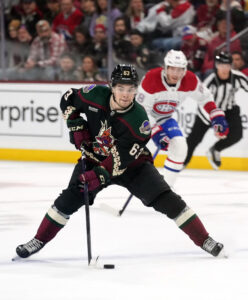With the 4 Nations Face-Off now complete, the trade deadline looms large and is just a few weeks away. Where does each team stand, and what moves should they be looking to make? We continue our look around the league with the Utah Hockey Club.
The Utah Hockey Club find themselves in an awkward spot with the Trade Deadline approaching. They’ve posted a perfectly .500 season – just good enough to stay within grasp of the Western Conference Wild Cards but not good enough to be planning for travel come May. Adding to the confusion is the return of Sean Durzi from an October injury. Durzi played in four games as a top-pair defenseman before falling to injury, and his return stands as a substantial, free addition to the Utah lineup at the perfect time. With the deadline just around the corner, Utah will need to quickly gauge where their lineup sits – with Durzi’s return, Clayton Keller’s top scoring, and Logan Cooley’s injury all complicating the matter.
Record
24-24-9, 5th in the Central Division
Deadline Status
Tepid Buyers
Deadline Cap Space
$27.07MM on deadline day, 1/3 retention spots used, 47/50 contract spots used, per PuckPedia.
Upcoming Draft Picks
2025: UTA 1st, UTA 2nd, UTA 3rd, UTA 4th, UTA 5th, UTA 6th
2026: UTA 1st, UTA 2nd, OTT 2nd, NYR 2nd, UTA 3rd, CAR 3rd, UTA 4th, UTA 5th, UTA 6th, UTA 7th
Trade Chips
On the heels of an up-and-down year, the Trade Deadline will be Utah’s chance to stake their claim. Are they a hopeful on the fringe of the playoffs, led by a clear top-scorer and strong goaltending? Or are they an up-and-comer, driven by succeeding top prospects and emerging structure? Their fate certainly seems in the latter camp, but Utah seems too close to the Western Conference wild cards – six points out, with one game lost – to take a full stride towards the future. The 26-year-old Clayton Keller – who leads the team with 61 points – or the 28-year-old Nick Schmaltz – right behind him with 48 – may be at their peak sale value this year. But much of the Utah success has been built around those veterans, and would leave major lineup holes by shipping them out.
That likely leaves Utah’s biggest bargaining chips in their lineup depth. Undersized winger Matias Maccelli has fallen to just 18 points in 52 games this season, after posting a career-high 40 assists and 57 points last year. He has been healthy scratched at multiple points this season, including in Utah’s first game back from the 4-Nations Face-Off break. That’s a dismal fall from grace for a player that averaged north of 16 minutes of ice time last season – and could be the signs of a looming separation. Maccelli is still only 24 years old, and proved the extent of his playmaking upside with 78 assists in 146 games between 2022 and 2024 – his first two full seasons in the NHL. This down year seems to be more a fluke, or clash of minds, than it is indicative of any decline – and a young scorer will always be a hot commodity on the open market. Even better, Maccelli carries a comfortable $3.43MM cap hit through the end of next season. Utah could be in store for plenty of attention by gauging Maccelli’s price on the open market.
Undersized winger Matias Maccelli has fallen to just 18 points in 52 games this season, after posting a career-high 40 assists and 57 points last year. He has been healthy scratched at multiple points this season, including in Utah’s first game back from the 4-Nations Face-Off break. That’s a dismal fall from grace for a player that averaged north of 16 minutes of ice time last season – and could be the signs of a looming separation. Maccelli is still only 24 years old, and proved the extent of his playmaking upside with 78 assists in 146 games between 2022 and 2024 – his first two full seasons in the NHL. This down year seems to be more a fluke, or clash of minds, than it is indicative of any decline – and a young scorer will always be a hot commodity on the open market. Even better, Maccelli carries a comfortable $3.43MM cap hit through the end of next season. Utah could be in store for plenty of attention by gauging Maccelli’s price on the open market.
Utah has also built up a small surplus in net. Connor Ingram started the year in the starter’s net, but lost it to Karel Vejmelka during a two-month absence to injury. Vejmelka now sits with a .909 save percentage, 2.57 goals-against-average, and a 13-15-4 record on the year. That’s a clear step up over Ingram’s .882 Sv%, 3.27 GAA, and 9-8-4 record. Utah also received a strong four games from Jaxson Stauber, who posted a 2-1-1 record and .925 Sv% during Ingram’s absence. Stauber also has an 8-5-1 record and .901 Sv% in 14 AHL games, where he backs up Matthew Villalta’s 12-17-3 record and .904 Sv%. That heap of well-performing netminders could land Ingram on the outside looking in.
Ingram posted a .907 in each of the last two seasons, playing in 27 and 50 games respectively. He’s a long-tenured pro who has worked his way into a cushy platoon role with Utah. Even better, Ingram carries an affordable $1.95MM cap hit through the end of next season. Those facts will keep Ingram an affordable depth option an open market with very few goalies.
If not Maccelli or Ingram, the sight of Utah’s trades will quickly turn towards their veterans. Each of Lawson Crouse, Alexander Kerfoot, and Nick Bjugstad have found reasonable footing in the Utah lineup, and could be cheap bets for deadline buyers looking for a specific style. Juuso Valimaki and Nick DeSimone offer similar low-upside but reliable styles on the back-end, though they likely couldn’t command the same asking price as other positions. That short list of bargaining pieces may set Utah up for a quiet spring, but strategic use of their 2026 draft picks could still make for notable additions.
Team Needs
1) Spark Plugs – Utah is coming into their own this season through the success of their young stars. Dylan Guenther and Logan Cooley are both rivaling point-per-game scoring, while Josh Doan and Artyom Duda are rising through the minor ranks. It’s clear to see the core pieces that Utah’s future will be built around – meaning they can turn their attention towards finding exciting complementary pieces. A winger that can bring added finesse and finishing ability to Cooley’s side, or a heavy passer to set up Guenther, could go far towards solidifying Utah’s next steps. Anaheim Ducks winger Trevor Zegras stands as the beacon of high-skill upside bets at this year’s deadline, but his asking price could quickly run Utah’s wallet dry. A more realistic bet may be aging Vancouver Canucks winger Brock Boeser, who has long been rumored to move and could carry a cheap asking price in the midst of a down year. Boeser has just 35 points this season, less than half of the 73 points he posted last year – helped along by his first 40-goal season. At 27, he may be a bit old for Utah’s young core – but for the right acquisition cost, Boeser could also be the big splash this year that ripples out through the next few seasons. Boeser carries a $6.65MM cap hit and a modified no-trade clause through the end of this season.
success of their young stars. Dylan Guenther and Logan Cooley are both rivaling point-per-game scoring, while Josh Doan and Artyom Duda are rising through the minor ranks. It’s clear to see the core pieces that Utah’s future will be built around – meaning they can turn their attention towards finding exciting complementary pieces. A winger that can bring added finesse and finishing ability to Cooley’s side, or a heavy passer to set up Guenther, could go far towards solidifying Utah’s next steps. Anaheim Ducks winger Trevor Zegras stands as the beacon of high-skill upside bets at this year’s deadline, but his asking price could quickly run Utah’s wallet dry. A more realistic bet may be aging Vancouver Canucks winger Brock Boeser, who has long been rumored to move and could carry a cheap asking price in the midst of a down year. Boeser has just 35 points this season, less than half of the 73 points he posted last year – helped along by his first 40-goal season. At 27, he may be a bit old for Utah’s young core – but for the right acquisition cost, Boeser could also be the big splash this year that ripples out through the next few seasons. Boeser carries a $6.65MM cap hit and a modified no-trade clause through the end of this season.
2) Younger Depth – For a team built around up-and-coming youngsters, finding the middle ground between youth and impact in the depths is incredibly important. Utah won’t be able to sustain their reliance on Bjugstad or Crouse to play the hard minutes. They need to cycle out their aged vets for a core that can better support the likes of Cooley and Guenther in the years to come. The open market could offer plenty of players that fit that mold, including shoot-first winger Nicholas Robertson in Toronto and heavy-hitter Trent Frederic in Boston. Even acquiring a player closer to their prime, like Boston’s Justin Brazeau or Columbus’ Mathieu Olivier, could stabilize a Utah bottom-six comprised largely of 30-year-olds. There will be a lot of options Utah can push in to build up their bottom pieces – but doing so without paying lavishly will have to be the priority.